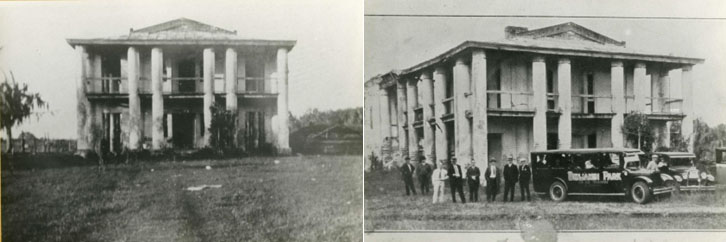Exploring Historic Preservation Processes in Florida
An Exhibition of the University of Florida Architecture Archives
Restoration at Gamble Mansion, Ellenton, Florida
Restoration returns a building to its condition at a specific time period.
The process of restoration recreates a specific moment in a building’s history, and as such, does not seek to preserve or retain all of the features that were added to the building or changed over time. Architectural features that are authentic for the chosen time period are retained or reconstructed, while features from other periods are removed.
In the 1840s, Major Robert Gamble, Jr. established a sugar plantation on the Gamble Mansion site. Although it was once one of the leading producers of sugar in Florida, the plantation was abandoned and neglected by the early 1900s.
 |
By the time these photographs were taken in the 1920s, the Gamble Mansion showed obvious signs of neglect and disrepair. The structure was also damaged during a hurricane in 1926.
The Gamble Mansion was acquired by the State of Florida in the 1920s, and over time, the building underwent a substantial restoration process to return it to its condition and appearance during its heyday in the 1840s and 1850s. Blueprints of the Mansion's exterior from the Smathers Libraries help document the restoration processes that took place at the site.
Restoration is often an ongoing process. In the 1970s, Herschel Shepard was contacted by the state of Florida for his professional guidance regarding restoration concerns at the Gamble Mansion. Some of the decisions that must be made during restoration include the paint colors that are historically accurate and the type of flooring that should be used to maintain the integrity of the historical period being portrayed.

|
Today, the Gamble Mansion Historic State Park, is a museum and park open to the public. Compare the way it looks today to the photographs from the 1920s. Notice in particular the state of the second floor railings and the windows. Restoring architectural elements such as these have helped return the Gamble Mansion to the way it looked as a prosperous sugar plantation. The conversation that has taken place over time regarding restoration at the Gamble Mansion has resulted in the preservation of the only surviving antebellum mansion in South Florida.
